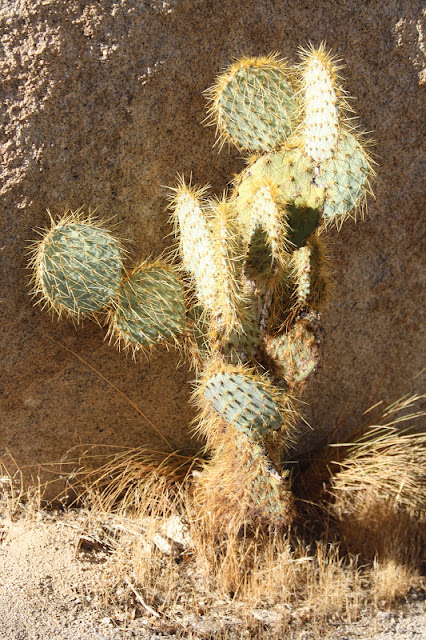I came across this little ladybird on the way to the Cholla Cactus Garden. Someone else in the car had found it crawling on their leg. It is a little
Psyllobora of some kind, a genus of very tiny little mildew ladybirds. They are seldom seen due to their size; image trying to find one in a very extensive field of bushes.
I suspect it is
Psyllobora renifer but I cannot find any evidence of it occuring any further west than Arizona. It is a distinctive species however so perhaps this shows either a range extension in the species or an unknown population. It certainly has the tendency to go unnoticed.
The Cholla Cactus Garden is somewhat well-known in the tourist industry. It is a giant field of Teddy-bear Cholla which is not found anywhere else. This cactus, while it looks furry, is not very welcoming. When you touch the spines they detach (along with a piece of the cactus) and embed themselves into your skin with barbed hooks. Good luck getting them out.
California Patch, Queen, Sleepy Orange and Cloudless Sulphur butterflies were present here (all but Sleepy Orange I will show pictures of later). Most of my photos were of reptiles and insects. I saw one bird very vaguely at the start but I could not see what it was.
 |
| Sleepy Orange; best shot I have, they don't seem to like sitting. |
Next stop was a location called Split Rock. It was a rocky (duh) location that had some pretty interesting hikes, many of which off path and involving climbing some ledges. Needless to say none of them led anywhere interesting so I stuck to the nature-y looking trails.
There were some very vocal White-throated Swifts over the canyon. I have never heard these birds calling before so it was quite an unusual experience to hear them.
The only other bird was a medium-sized long-tailed bird that flew into a bush just underneath me. I originally thought it was a Say's Phoebe but the features were wrong. It took a bit of time but I finally worked out it had to be a
Townsend's Solitaire; certainly not something I would expect around here. Solitaires were a mountain bird, and the nearest mountains were quite far off. From some research it seems they are a regular bird here in winter each year but in very minute numbers. Seeing it in flight confirmed my suspicions.
Here are some other photos from the site:
 |
| Dusky Chipmunk of the southern subspecies Tamias obscurus davisi |
 |
| California Patch (top of photo, I honestly never got a better picture). |
Next up was the Barker Dam region of the desert.

There was indeed a dam here, but it was by no means a large scale dam like you may picture, and at this time of year there wasn't even any water, though it did manage to attract quite a few tourists. In the car park there was a White Chequered-skipper. Luckily here there was no issue of separating it from the identical Common Chequered-skipper (in areas where they coexist the only way of telling them is by microscopic dissection of genitalia, what a job that is...) as the Common does not stray this far south nor does it favour the desert.
 |
| Yay, I don't have to list it as Chequered-skipped sp. I can actually put the silly little thing to species. |
Many of the flora here was unique to the desert. Usually I don't post photos of wildflowers on this blog but sometimes I make exceptions.
 |
| Turbinella Oak (ssp. turbinella), a special desert subspecies of the Coastal Live Oak (dumosa). I think it is its own species now. |
 |
| Opuntia chlorotica, sometimes called the Pancake or Flapjack Pricky Pear. |
 |
| Opuntia littoralis. |
 |
| Echinocactus polycephalus |
Since there was still time left we made another stop at Hidden Valley. It was like Split Rock but a little more unique.
Here there were even more White-throated Swifts. It was apparent that they were gathering around here to roost in the coming hour.
Everyone else split up to "boulder-hop" the cliffs and I ended up taking a walk with the Marine Biology teacher (who I learned took Ornithology in college and he actually knows a hell of a lot of content). A peculiar jay call in the trees over the hill sounded eerily like Pinyon Jay but it could not be confirmed. I found a Western Scrub-jay in the area, but I was sure it sounded like Pinyon. Near the end of the trail we found a
Rock Wren perched on the cliffside. Rock Wrens are funny little birds. Take a typical House Wren (or Eurasian Wren) and make it crawl up cliffs (x Wallcreeper or Nuthatch) and you have a Rock Wren.
 |
| Small and brown but an unmistakable bird. |
 |
| See if you can find it. Hint: its small and brown. |
I managed to get some extra birding time in when three of the students went missing. Not that birding was the most important thing. Nevertheless they eventually returned, apparently "stuck" but without the sense to use their emergency whistle. On the way out I saw this bat flying high around the cliffs and managed to astound many people since they could not work out how I differentiated it from a bird.
























